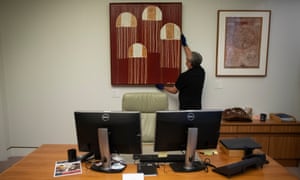[ad_1]
Deep in the basement of Parliament House, Justine van Mourik flits between racks of paintings, marble busts and giant colonial portraits.
Van Mourik’s attention jumps from one piece to the next in the vast art collection that she oversees for the Department of Parliamentary Services, each piece sparking its own story.
There’s the gaudy-looking Queen’s Beasts vase – a celebrated feat of ceramic engineering to mark the Queen’s coronation in 1953 which was once wrongly put back together after cleaning.
There’s a set of boxed-up Georg Jensen candelabras – a gift from each of the five Scandinavian countries when the new parliament house opened in 1988, while just arrived is a series of striking digital prints from contemporary WA artist Lucille Martin.
There are Arthur Boyds, Howard Arkleys, Mavis Ngallamettas, Clifton Pughs and Richard Bells all jostling for space.
This week, the climate and humidity-controlled store room in the bowels of the building has been a frenzy of activity as the department gears up to adorn the walls of the 46th parliament.
An Indigenous painting of jelly fish – a favourite of environment minister Sussan Ley – is on the “toast rack”, being readied for installation in the ministerial wing before Parliament resumes on Monday.
In a ritual that marks the beginning of each parliament, MPs and senators have begun perusing the department’s eclectic art catalogue to decide which works they will have in their offices.
There is a strict pecking order. The prime minister gets first pick, followed by presiding officers – the Senate president and speaker of the House – then cabinet ministers, and so on.
Backbenchers are down the list, but van Mourik says she tries to ensure newcomers get in early to make their offices more welcoming.
“It is a huge job, although a change of government is much more work than a returning government,” she says.

“It is like running a big regional gallery inside a miniature super council, except there are 227 councillors.”
While mostly hidden from public view, DPS’s collection comprises about 7,000 individual pieces, about half of which is on display at any one time throughout Parliament House’s 4,500 rooms and 22km of corridors. Its estimated value is in the order of $120m.
Along with its historic memorials collection, gifts from foreign governments and pieces commissioned for the building’s opening, the department also boasts an impressive “rotational collection”, which comprises contemporary and Indigenous art.
For this collection, the department has a unique acquisition strategy – it buys only from the primary market, ensuring the artist receives the full benefit.
“The purpose of art in the building is not to be a gallery, it really is more to provide a kind of environment that is conducive to work, it is more of a domestic setting. It’s like furnishing a very large house.
“You want things that people can live with given how much time people spend in this building.

“[But] it is also about providing inspiration, we don’t want people to walk past the same thing every day for three years.”
At times, MPs and senators eye off each others’ works, and a demotion can often mean losing an artwork that won’t fit in a new, smaller office.
“If you are going from a larger allocation to a smaller allocation we usually suggest that they give up the really big work that doesn’t fit into a backbencher’s suite, but we try not to take things off people that really, really love them,” van Mourik said.
Ley eyed off the jellyfish painting, painted by Kokoberrin woman Lisa Michl Ko-manggén from the west coast of Cape York Peninsula, when it was hanging in Ken Wyatt’s office – an office she now occupies.
“The painting was in the office when Ken Wyatt was there and he was kind enough to allow it to remain when the offices were changed with the new ministries,” Ley said.
“I liked the painting from the moment I saw it and asked if it could be kept there.”
Ley said jellyfish played an important role in the environment and in Indigenous story-telling and so it “seemed a good fit for the office”.
“I also have fond memories of swimming in the Persian Gulf with jellyfish when I lived there as a child, and that probably added to the way I feel about it.”
The deputy senate president, Sue Lines, who is on the committee that helps select new art acquisitions each year, said that she had chosen mostly work from the Gidja indigenous people of WA, but also had a Danie Mellor dog sculpture that her staff referred to as Rex.
“There is a nice picture in the [senate] president’s office of the Franklin river, but he hasn’t given that up yet,”
“And Penny [Wong] has a beautiful Tracey Moffatt in her office, but who would take a painting off Penny. That’s off limits.”
[ad_2]
READ SOURCE


